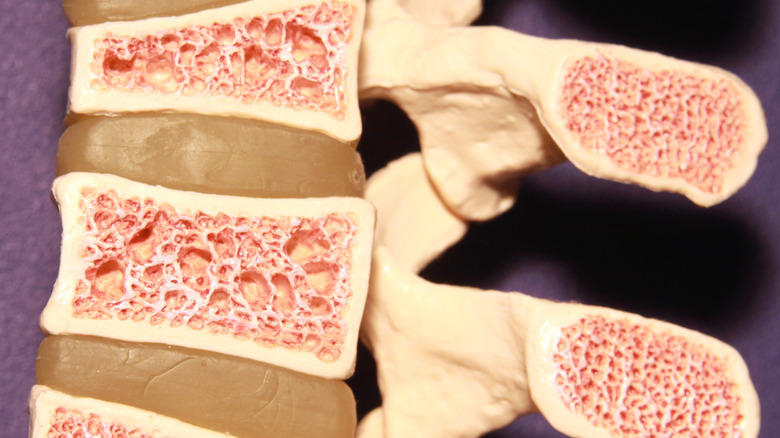This Rare Genetic Mutation Gives People Unbreakable Bones
Imagine this: You are in a horrendous train derailment. Of 132 passengers on the train, you're the only one to survive. Not only are you alive, but you emerge from the wreckage with nary a broken bone.
OK, that's obviously a scene from the 2000 movie "Unbreakable." It's not real life, but there are elements in the scene that do have a link to reality.
In 1994, a man was in a car accident. X-rays revealed no injuries to his bones or spine, but one thing was odd: His bones were exceptionally dense. The man's radiologist referred him to Karl Insogna, director of the Yale Bone Center, who discovered that the man's skeleton was eight times denser than that of an average man his age (via The Scientist). The man, however, showed no symptoms or any indication there was a problem.
Then, six years later, Insogna crossed paths with a physician who had seen a family whose members had extremely high bone density. After researching the family tree, Insogna found that the man who survived the car crash in 1994 without any broken bones was part of that family.
This case was the foreshadowing of research by multiple scientific teams that culminated in the discovery of a genetic mutation on chromosome 11 called LRP5, which was initially linked to low bone density by researchers in Cleveland, Ohio. But Insogna and his team suspected LRP5 could be associated with high bone density too.
How did this man get super strong bones?
Meanwhile, scientists in Nebraska were studying 21 members of another family with very dense bones. "None of those people, ranging in age from 3 to 93, had ever had a broken bone," Mark Johnson, who led the team at Creighton University in Omaha, told The Scientist.
Johnson's team found a link between LRP5 and a signaling pathway (a group of molecules working together in a cell to control a function) that's important for growth and development. They then discovered the pathway was also essential for regulating bone mass.
The LRP5 mutation can lead to two distinct skeletal conditions, depending on whether it causes low bone activity or bone overactivity. If it causes low activity, bones that are formed are brittle and easily fractured. Overactivity, in contrast, leads to extremely strong bones that are resistant to breaking. People with this specific type of mutation can easily replace old bone as well as remodel bones to meet new demands (via The Conversation). This condition is known as sclerosteosis (per The Science Explorer).
In addition to highly dense bones, those affected by sclerosteosis have an unusually square jaw, a bony growth on the roof of the mouth, and trouble floating in water.
Super strong bones that resist breaking come with a price, however. Unchecked bone growth can compress nerves or put pressure on the brain, leading to problems with hearing, balance, vision, sensation, and motor function.
How the discovery of the "unbreakable bones" gene mutation led to a treatment
The discovery of the genetic mutation LRP5 was exciting to researchers hoping to find treatments for bone disorders such as osteoporosis, a common condition in which bones become brittle and easily fractured, and osteopetrosis, a condition typically diagnosed in babies and young children where bones are dense but exceedingly fragile (per The Conversation).
How could the discovery of LRP5 help with treating osteoporosis? It has to do with a protein that normally prevents bones from growing too thick.
In sclerosteosis, this protein is missing (per The Science Explorer), so bone formation continues unchecked, whereas in osteoporosis, the creation of new bone can't keep pace with the loss of old bone due to the activity of this protein (via the Mayo Clinic). To find a way to minimize the effect of the protein, scientists created antibodies and honed in on the one that could potentially block the protein in patients with osteoporosis. The result is a medication called romosozumab, which is the first new class of drug for treating osteoporosis since 2010 (via Harvard Health Publishing).
With the discovery of what causes the "strongest bones on the planet," as one researcher described the bones of families affected by sclerosteosis, came a new treatment for those suffering from osteoporosis. The man who survived the car accident in 1994 won't benefit from the research that created romosozumab — he and his family still have the advantages and disadvantages of super strong bones — but he contributed to the discovery of a new drug for people whose bones are much more fragile. In that sense, he truly is a superhero.



